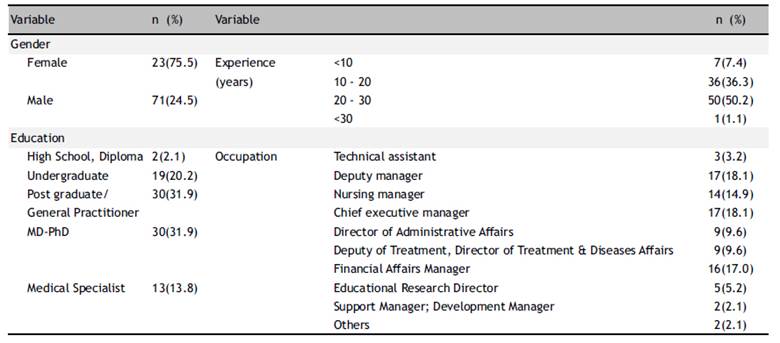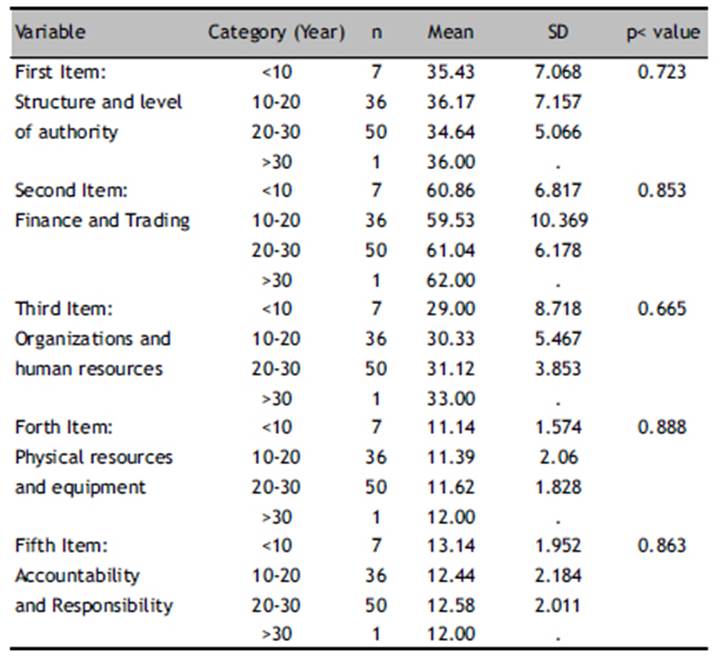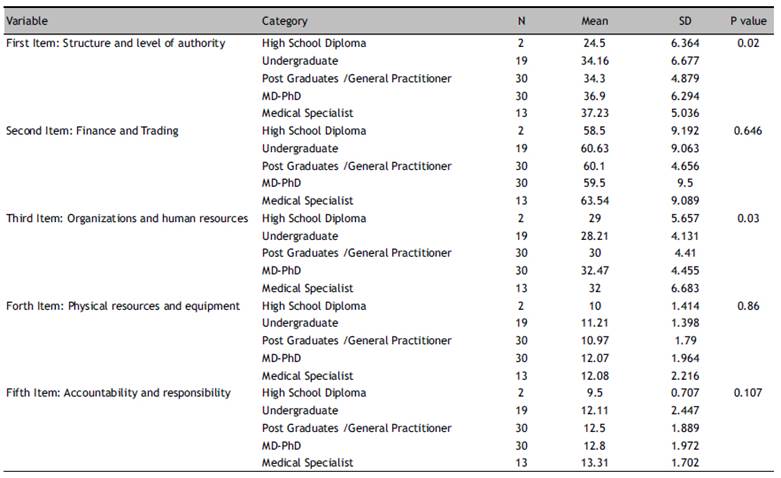INTRODUCTION
Governments have to intervene in the health market due to the difference between the health market and what is called a fully competitive market. It is mainly because the need for health care is unpredictable and these services are expensive. On the other hand, the low efficiency and productivity of many state-owned enterprises as well as the poor quality of government-provided services, and finally the cost pressures in both developed and developing countries make the question of whether health organizations must necessarily be managed by governments 1. In 1994, a new structure of hospital administration, known as the hospital autonomy, was introduced for applying at all university of medical sciences by the deputy minister of health at the ministry of health and medical education. According to this framework, the hospital, as a health, treatment, educational and research center, should provide medical services at the level of qualitative and quantitative standards in return to receiving money from either the customer or contract insurance company for the cost of services based on tariff approved by the Ministry of Health and Medical Education. This income in fact should be spent for purchasing of medical and non-medical consumables and services supported by the hospital contracting companies (housekeeping, cooking, transportation services, etc.) and Personnel expenditure (overtime, labor, clothing allowance, etc.). The public sector hospitals in our country have been managed in different ways so far, each of which has its advantages and disadvantages. 2 In many countries, public hospitals have applied some reforms with the aim of independent management as well as separation of buyer and service provider responsibilities. These reforms have sought to increase market power in hospitals. Many of these reforms have failed to accomplish hospital’s goals, and there is still insufficient evidence for supporting efficiency of these reforms 3. Many African countries have implemented reforms to increase hospital independence since the late 1980s 4. The reasons for these reforms have been widely endorsed 5,6. In fact, the core of these reforms in the hospital management system goes back to the World Bank's Health, Nutrition and Population Division 7. Hospital and financial management reforms have been adapted from US Agency for International Development's hospital reform programs 8, as well as UK management development program 9. The reform has spread to developing countries and performed in various forms. Alternative mechanisms for financing contractual services and separating buyers from service providers, as well as enhancing the role of the private sector in the public and public sector, internal management reforms, such as the development of the management system, and the development of the information system and budgetary reforms have considered some of these reforms, however the key point was that the main goal of all of these reforms was to reallocate and optimize funds and resources in the form of essential care packages and increase community participation in health service management 10,11,12,13,14,15.
Decentralization in the health system is performed for increasing the impact of health and medical interventions, achieving justice, enhancing health efficiency, improving quality, providing fair and equitable funding and planning for the most appropriate intervention based on the region's priorities. Decentralization is used as the main component of the reform process in the health system 16. Reforms in the country's health system are in progress under Article 192b of the Third Development Plan, Article 88 of the Partial Regulation of Government Financial Regulations 2001, Articles 49 and 88 of the Fourth Development Plan Act and other laws 17.
Considering that independent hospital plans as well as security board schemes have been executed for many years and collapsed consequently, however, they have been launched again in the hospitals of Iran University of Medical Sciences which is in priority and it requires a considerable amount of consideration. In this study, reviewing the experts' viewpoint about the implementation of the plan in independent hospitals, we helped for discovering the challenges and obstacles of the project implementation and to showing the fact that what extent the model has been complete and comprehensive and has been able to achieve successful goals for designing a comprehensive and permanent model
MATERIALS AND METHOD
The study was conducted at Iran University of Medical Sciences and affiliated hospitals and the sample of study included total of 94 people including university dean, deputies and chief executives of hospitals, educational and research deputies, therapists and professionals. According to the method, it is a descriptive-survey research and since the results are pragmatic it is a practical research. On the other hand, this research can be considered as developmental study because it seeks to identify obstacles and provide the necessary infrastructure by conducting study and follow-up. Questionnaire was used as data collection tools and field data collection method.
In this study we used literature review and examined the performance models in Iran and then selected hospitals in other countries. We used an extensive search strategy to get the most resources relevant to the topic. We searched both Persian and English electronic articles and resources related to the topic, Google Scholar, PubMed, Iran DOC and Web of Science.
During the distribution of questionnaires we asked society about the challenges and problems of the extraction plan as well as the factors affected the extraction (All of the questions in questionnaire were extracted from the Implementation Items of Independent Hospitals).
Statistical Analysis
Mean ± standard deviation was used to describe quantitative variables; and categorical data were described using counts and percentages One-way ANOVA was used for comparison of two means. P value was set at 0.05. The Cronbach’s alpha coefficient was used to obtain the internal consistency. Statistical Analysis was done using Statistical Package for Social Sciences, version 21.0 (IBM SPSS Statistics Inc., Chicago, IL, USA)
RESULTS
In this study, 94 people were evaluated including university dean, deputies and chief executives and chiefs, managers and assistants of hospitals, educational and research and treatment deputies and informed experts in this field. The mean age of participants was 47.24 ± 5.41 years. Other demographic characteristics of the participants are shown in Table 1.
Cronbach's alpha for 41 questions was used to assess the reliability of the questionnaire. Given that the alpha coefficient in the first column is 0.843, it is found that these questions have good internal consistency and hidden variable are able to be measured. The next section shows the correlation matrix as well as the covariance matrix.
Reliability Statistics
Cronbach's Alpha: 0.843 y Cronbach's Alpha Based on Standardized Items: 0.846
The mean scores of the five items were evaluated based on experience, and the results showed that the mean score of all domains based on experience time was not significantly different (P> 0.05). Table 2 shows the mean and standard deviation of the five items' score based on the experience time.
The mean scores of the five items were evaluated based on education level and the results showed that the mean score of all items in the first and third domains was statistically significant (p <0.05). In other areas there was no significant difference based on education level (p> 0.05). The results of the post hoc tests showed that in the first domain the undergraduate scores were significantly lower than the other categories (p <0.05) and in the third domain the mean scores of the bachelor degree were significantly lower than those of PhD or medical specialist (p <0.05). Also, the mean scores of master's degree or general practitioners were significantly lower than those of specialist doctor's or PHD's (p <0.05). Table 3 shows the mean and standard deviation of the five items scores by education level.
Table Nº3. Mean and stadard deviation scores of five items based on Education Level
DISCUSSION
Public (governmental) hospitals in our country have so far managed in different ways, each of which has its disadvantages and advantages 2. In many countries, the experience of public hospital reforms has been aimed to manage independently the role of purchaser and service provider, which contributes to increasing the efficiency of hospitals 3. African countries have also introduced reforms to increase hospital independency 4. Many health systems use decentralization as the main component of the health system reform process 16. The question was this: Where is the core of these reforms in fact? The answer is that in the hospital management system is related to the World Bank's health, nutrition and population 7. The main goal of all of these reforms has been to reallocate and optimize funds and resources in the form of essential care packages and to increase community participation in health service management 15. In this study, the redesigned model of hospital administration was evaluated independently in Iran University of Medical Sciences hospitals. Cronbach's alpha for 41 questions was used to assess the reliability of the questionnaire. Given that the coefficient alpha coefficient was 0.843, it is found that these questions have good internal consistency and can measure a hidden variable. Since the implementation of the hospital plan has been implemented independently and the hospital security committee has been operating in the hospitals for many years but has been canceled after a while due to problems and challenges. It was implemented now again in the hospitals of Iran University of Medical Sciences. Generally, the final key items of this research were structure and level of authority (first item), finance and trading (second item), organizations and human resources (third item), physical resources and equipment (fourth item), and accountability and responsibility (fifth item). Ferdosi et al., in a study on the responsiveness of board of trustees hospitals based on the World Bank's Organizational reform model in Isfahan in 2013, concluded that the presence of board of trustees (municipality and office of the governor) in Isfahan Hospitals was not full-fledged despite being a member of the board of trustees. The plan concludes that it is better for hospital to be as independent as they are able to make decisions, compete in the marketplace, and change the responsiveness of the structure to suit the restructuring and establishment of the board of trustees 18.
Tavakkoli et al., in a study on the performance of the supervisory board of the new system of hospitals administration in selected medical education centers in Isfahan in 2016 has concluded that the most prominent findings of this study include weaknesses in structural and infrastructure factors in the implementation of the plan. These findings help health sector policymakers to identify the weaknesses of appropriate strategies to reduce them in the new business plan 19, then the independence of hospital management can determine the better condition of hospital management. Our study also concludes that a model based on the autonomy of hospital management can be applied separately from government intervention.
In 2004, in a study examining the problems of hospital reform in France, the authors concluded that reforms in French hospitals were not fully successful and in some areas, such as planning problems, compared to reforms in Canada have made hospital reform in France less successful 20. In 2008, in a study of a slow transition, the law as a factor in changing the health system in the US concluded that a slow change in the law as a factor in changing the health system changed the Supreme Court's regulatory environment. Understandably, however, the greater influence has been indirect law. In this article, the impact of the law on health system change is discussed. Federal and state courts have changed the rules of the medical market, limiting existing ways to manage care organizations to succeed in cost control. Health plans change business strategy, providing off-the-shelf support for offensive cost management, with four lessons on the role of law in field health-lessons that emphasize the power of legal conflict to shape perceptions and change outcomes. The behavior concludes before legal change occurs 21.
In 1996, McPake conducted a study examining the process and changes of autonomous public hospitals in sub-Saharan Africa. The results showed little change in the efficiency of autonomous hospitals compared to budgetary hospitals. There was no clear evidence of hospital board of trustee and further research was suggested. Improved accountability and attention to patients in these hospitals were higher than budget hospitals 3. Als, McPake et al., in 1994 conducted a study examining the impact of hospital reform on improving the performance of hospitals in Colombia. The study was a quantitative study using time series analysis. The results showed that there was little evidence of increased activity, productivity, and service quality of staff in the studied hospitals. The results of the study showed that there was a significant change in the responsiveness of patients in terms of staff but these changes increased the volume of management affairs in hospitals. The lack of appropriate data has prevented a full evaluation of the impacts in hospitals, and it is recommended to investigate these changes in larger dimensions 11. Janati et al. in 2017 conducted a study entitled "Health care managers’ perspectives on the sources of evidence in evidence-based hospital management" and showed that the evidence-based hospital management is efficient for making hospital decisions 22.
In Italy, Ferretti et al. in 2014 reveled that health logistics are traditionally ignored and it is not suitable strategy. More recently, Italian Central Government and Region have reviewed costs only in the direction of a curtailing of the pro-patient cost particularly in pharmaceutics area and concluded that for best management health logistics must be applied 23.
Karimi, in a study called the " The New ManegeriaI Approach for Hospital Administration: Weakness and Provision" concluded that some reason inhibited their approach to achieve the optimum results including 1) the inability of clients to pay; 2) depreciation of hospital buildings and facilities, and lack of rehabilitation and treatment; 3) Significant difference in the earnings of public and private practitioners; and 4) reduction of incentives for non-medical personnel. Without the above mentioned problems, this approach can achieve a high level of community health and public satisfaction. This failure has led to numerous objections. It has been suggested by the people, experts and officials of the health sector and the executive authorities of the country that some of them have proposed to cancel this plan, but it seems that this plan needs to be amended and its cancellation is not recommended 2.
Totally, modern hospital management system should be independence and Yan et al. in 2018 revealed this fact (24). Albeit, addition to independency of hospital in the management process, it must be considered that hospital management is strongly related to hospital performance on clinical quality metrics. So that Tsai et al. in 2014 showed the same findings 25.
Domanico in an article reviewed the success of an independent hospital in 2017. While many hospitals follow this approach, our experience at Marian General Hospital (MGH) showed that hospital independency can be a good choice. Independent hospital system management has also had some challenges, including achieving financial stability, possessing and acquiring the technology needed, creating a strong position in the local health landscape, and raising $ 500 million in funding to rebuild facilities around earthquake safety standards 26. Although the challenges seemed difficult, we recognized several benefits and used them as the basis of short- and long-term strategic planning.
According to the main items in this research (1: structure and level of authority; 2:finance and trading; 3:organizations and human resources; 4: physical resources and equipment; 5: accountability and responsibility), the independence of hospital management can be considered as effective factor to manage hospital better . Also, it can improve the efficacy of services and satisfy the patients and staff

















